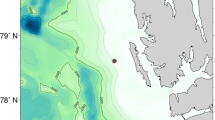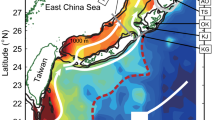Abstract
Using hydrographic measurements from three recent surveys in the western tropical Pacific, this study revealed the existence and general features of thermohaline finestructure near the northern Philippine coast. Pronounced finestructures were detected in the layers of the North Pacific Tropical Water (NPTW) and the North Pacific Intermediate Water (NPIW) during all three cruises and shown to be mainly thermohaline intrusions. Characteristics of the intrusions were further investigated with spiciness curvature and salinity anomaly methods. The vertical scale of the intrusions was 20–50 m and 50–100 m in the NPTW and NPIW layers, respectively. Within the NPTW layer, the Turner angle distribution and correlation between salinity and density anomalies suggested that diffusive convection between surface fresh water and subsurface saline water played an important role in the development and maintenance of the intrusions. In addition, connection between thermohaline finestructure and larger-scale oceanic processes was explored using historical hydrographic data. The results reveal that the salinity field and the distribution of the intrusions in this region were largely determined by mesoscale eddies. As a result of eddy stirring, both isopycnal and diapycnal temperature/salinity gradients were strengthened, which gave rise to the development of thermohaline intrusions. The intrusions acted to enhance heat and salt fluxes and resulted in the mixing of water masses being more efficient. By linking mesoscale eddy stirring to micro-scale diffusion, thermohaline finestructure plays a vital role in the ocean energy cascade and water mass conversion in the northern Philippine Sea.
Similar content being viewed by others
References
Beal L M. 2007. Is interleaving in the Agulhas Current driven by near-inertial velocity perturbation? J. Phys. Oceanogr., 37: 932–945.
Bingham F M, Lukas R. 1994. The southward intrusion of North Pacific Intermediate Water along the Mindanao coast. J. Phys. Oceanogr., 24: 141–154.
Boyer T P, Antonov J I, Baranova O K et al. 2009. World Ocean Database 2009. In: Levitus S ed. NOAA Atlas NESDIS 66, U. S. Gov. Printing Office, Wash., D. C. 216p.
Ferrari R, Polzin K L. 2005. Finescale structure of the T — S relation in the eastern North Atlantic. J. Phys. Oceanogr., 35: 1 437–1 454.
Flament P. 2002. A state variable for characterizing water masses and their diffusive stability: spiciness. Prog. Oceanogr., 54: 493–501.
Garrett C. 1982. On the parameterization of diapycnal fluxes due to double-diffusive intrusions. J. Phys. Oceanogr., 12: 952–959.
Georgi D T. 1981. On the relationship between the large-scale property variations and fine structure in the Circumpolar Deep Water. J. Geophys. Res., 86(C7): 6 556–6 566.
Gould J. The Argo steering team. 2004. Argo profiling floats bring new era of in situ ocean observations. EOS Trans. AGU, 85(19): 185, http://dx.doi.org/10.1029/2004EO190002.
Horne E. 1978. Interleaving at the subsurface front in the slope water off Nova Scotia. J. Geophys. Res., 83(C7): 3 659–3 671.
Joyce T M. 1976. Large-scale variations in small-scale temperature/salinity finestructure in the main thermocline of the northwest Atlantic. Deep — Sea Res., Part II, 23: 1 175–1 186.
Lukas R, Firing E, Hacker P, Richardson P L, Collins C A, Fine R, Gammon R. 1991. Observations of the Mindanao Current during the western equatorial Pacific Ocean circulation study. J. Geophys. Res., 96: 7 089–7 104.
May B D, Kelly D E. 1997. Effect of baroclinicity on doublediffusive interleaving. J. Phys. Oceanogr., 27: 1 997–2 008.
McDougall T J. 1984. The relative roles of diapycnal and isopycnal mixing on subsurface water mass conversion. J. Phys. Oceanogr., 14: 1 577–1 589.
Qiu B. 1999. Seasonal eddy field modulation of the North Pacific Subtropical Countercurrent: TOPEX/Poseidon observations and theory. J. Phys. Oceanogr., 29(10): 2 471–2 486.
Qiu B, Lukas R. 1996. Seasonal and interannual variability of the North Equatorial Current, the Mindanao Current and the Kuroshio along the Pacific western boundary. J. Geophys. Res., 101: 12 315–12 330.
Qu T, Kagimoto T, Yamagata T. 1997. A subsurface countercurrent along the east coast of Luzon. Deep-S ea Res., Part I, 44: 413–423.
Qu T, Mitsudera H, Yamagata T. 1998. On the western boundary currents in the Philippine Sea. J. Geophys. Res., 103: 7 537–7 548.
Qu T, Mitsudera H, Yamagata T. 1999. A climatology of the circulation and water mass distribution near the Philippine coast. J. Phys. Oceanogr., 29: 1 488–1 505.
Qu T, Lindstrom E J. 2004. Northward intrusion of Antarctic intermediate water in the western Pacific. J. Phys. Oceanogr., 34: 2 104–2 118.
Richards K, Banks H. 2002. Characteristics of interleaving in the western equatorial Pacific. J. Geophys. Res., 107(C12): 3 231, http://dx.doi.org/10.1029/2001JC000971.
Ruddick B R, Turner J S. 1979. The vertical length scale of double-diffusive intrusions. Deep — Sea Res., 26A: 903–913.
Ruddick B R, Walsh D. 1994. Observations of density perturbations which drive thermohaline intrusions, in Double-Diffusive Convection. Geophys. Monogr., 94: 329–334.
Ruddick B R, Richards K. 2003. Oceanic thermohaline intrusions: observations. Prog. Oceanogr., 56: 499–527.
Schmitt R W. 1994. Double diffusion in oceanography. Ann. Rev. Fluid Mech., 26: 255–285.
Smyth W D. 2008. Instabilities of a baroclinic, double diffusive frontal zone. J. Phys. Oceanogr., 38: 840–861.
Smyth W D, Ruddick B. 2010. Effects of ambient turbulence on interleaving at a baroclinic front. J. Phys. Oceanogr., 40: 685–712.
Stern M E. 1967. Lateral mixing of water masses. Deep — Sea Res., 14: 747–753.
Shcherbina A Y, Gregg M C, Alford M H et al. 2009. Characterizing thermohaline intrusions in the north Pacific subtropical front zone. J. Phys. Oceanogr., 39: 2 735–2 756.
Talley L D, Yun J Y. 2001. The role of cabbeling and double diffusion in setting the density of the North Pacific Intermediate Water salinity minimum. J. Phys. Oceanogr., 31: 1 538–1 549.
Toole J M, Georgi D T. 1981. On the dynamics and effects of double-diffusively driven intrusions. Progr. Oceanogr., 10: 123–145.
Walsh D, Ruddick B. 2000. Double-diffusive interleaving in the presence of turbulence—the effect of a nonconstant flux ratio. J. Phys. Oceanogr., 30: 2 231–2 245.
Wang F, Hu D. 2010. Introduction to international NPOCE program. Chin. J. Oceanol. Limnol., 28: 953.
Zhurbas V, Oh I S. 2001. Can turbulence suppress double-diffusively driven interleaving completely? J. Phys. Oceanogr., 31: 2 251–2 254.
Author information
Authors and Affiliations
Corresponding author
Additional information
Supported by the National Natural Science Foundation of China (No. 40890152) and the Knowledge Innovation Program of Chinese Academy of Sciences (No. KZCX2-YW-Q11-02)
Rights and permissions
About this article
Cite this article
Wang, F., Li, Y. Thermohaline finestructure observed near the northern Philippine coast. Chin. J. Ocean. Limnol. 30, 1033–1044 (2012). https://doi.org/10.1007/s00343-012-1246-0
Received:
Accepted:
Published:
Issue Date:
DOI: https://doi.org/10.1007/s00343-012-1246-0




